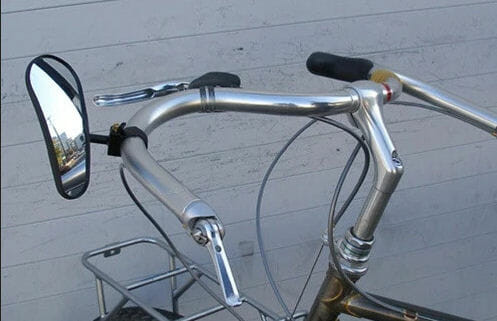Navigating roads on a bicycle requires constant awareness, especially of what’s happening behind you. While no law mandates it in North America, the question often arises: should cyclists use a rear-view mirror? From a safety and practicality standpoint, the answer leans towards a resounding “yes,” particularly for beginners and anyone wanting enhanced road awareness.
 Shannon Martin with EVT Safe Zone bike mirror for enhanced visibility
Shannon Martin with EVT Safe Zone bike mirror for enhanced visibility
Unlike drivers encased in vehicles with multiple mirrors, cyclists rely on their senses and physical ability to check their surroundings. While a clear view to the rear is inherently available simply by turning your head, the reality of cycling on busy roads introduces complexities. For novice riders still developing bike handling skills, turning the head to look back can lead to swerving, compromising balance and safety. The sound of approaching vehicles without visual confirmation can be unsettling, contributing to the tendency to ride too close to the curb or even avoid roads altogether. This is where a Bike Rear View Mirror becomes an invaluable tool.
The Advantage of a Quick Glance Back
The primary benefit of a bike rear view mirror is the ability to quickly assess the traffic situation behind you without significantly altering your riding posture or losing focus on the road ahead. A simple glance at the mirror provides crucial information about approaching vehicles, fellow cyclists, or potential hazards. This enhances your overall awareness and allows for more confident and safer decision-making on the road.
However, it’s crucial to understand that bike mirrors, like those on cars, are not foolproof. They all have blind spots.
Just as experienced drivers know to perform a head check when changing lanes, cyclists should maintain the habit of turning their heads to visually confirm their surroundings before making any significant changes in road position. While a mirror reduces the frequency and extent of head-turning needed, it doesn’t eliminate the necessity entirely. A quick shoulder check ensures you’re not missing anything in the mirror’s blind spot, especially before maneuvers like overtaking or turning. Mastering the skill of looking behind you without swerving remains a fundamental cycling skill, even with the aid of a mirror.
Bike rear view mirrors come in various designs, primarily categorized by their mounting location: handlebar, helmet, or eyeglasses. Each type offers unique advantages and considerations.
 Handlebar mounted bike mirror providing rear visibility for cyclist
Handlebar mounted bike mirror providing rear visibility for cyclist
Exploring Handlebar Mirrors
Handlebar mirrors are a popular choice due to their stable mounting and relatively large reflective surface. They typically attach to the handlebar in two ways: using a clamp that tightens around the bar, or with an expanding plug that fits into the handlebar end. The compatibility depends on your handlebar type and existing accessories like shifters or brake levers.
Many handlebar mirrors utilize a convex lens. This design provides a wider field of view, allowing you to see more of what’s behind you. However, convex mirrors also distort distance, making objects appear further away than they actually are – hence the “objects are closer than they appear” warning. Unless the mirror has a significant vertical extension, its viewing angle is optimized for a specific riding posture. Your body can obstruct the view to the opposite side, so in countries with right-hand driving, mounting the mirror on the left side is generally recommended.
Some handlebar mirrors feature a ball joint, allowing for on-the-fly adjustments. This is particularly useful when navigating curves or changing your riding position, ensuring optimal rear visibility is maintained.
Helmet and Eyeglass Mirrors: Alternative Visibility Options
Helmet and eyeglass mirrors offer different advantages, prioritizing a consistent field of view regardless of handlebar type or bike setup.
These mirrors typically use a flat lens. Unlike convex mirrors that provide a wide but distorted view, flat mirrors offer a more accurate representation of distance, though with a narrower field of view. Helmet and eyeglass mirrors are designed to be viewed with one eye, requiring a slightly different approach to usage.
Eye dominance plays a role in positioning these types of mirrors. Most people have a dominant eye, and aligning the mirror with that side optimizes visual processing. To determine your dominant eye, point a finger at a distant object and alternate closing each eye. The eye where your finger remains aligned with the object is your dominant eye. Positioning the mirror on your dominant eye side allows your brain to naturally prioritize the mirror’s view.
 Correct placement of helmet mirror for optimal rear view while cycling
Correct placement of helmet mirror for optimal rear view while cycling
Optimal placement for helmet or eyeglass mirrors involves positioning them as far to the side as possible while still allowing your opposite eye to maintain a forward view. Experimentation and adjustment are key to finding the sweet spot. Larger helmet mirrors offer more flexibility in positioning, which can be beneficial for riders with bulkier hairstyles or helmet designs.
The mirror should be angled to capture a direct or near-direct rear view. Minor head tilts can adjust the viewing angle, accommodating various riding positions, except for extremely low, aerodynamic racing postures. Scanning to the sides is achieved by subtle head movements while maintaining focus within the mirror.
Adjusting to helmet or eyeglass mirrors often takes time and practice. Using a reference point within the mirror, such as your ear, helmet strap, or hair visible at the edge, can aid in initially orienting the mirror and confirming its direction.
 Cyclist Jerry Campbell with helmet mirror illustrating eye dominance consideration
Cyclist Jerry Campbell with helmet mirror illustrating eye dominance consideration
Weighing the Pros and Cons of Different Bike Mirrors
Each type of bike rear view mirror presents its own set of advantages and disadvantages:
- Helmet Mirrors: Conveniently always available when wearing a helmet. However, secure attachment is crucial, and may require additional adhesives for some models.
- Eyeglass Mirrors: Easily portable and usable across different bikes or even without a helmet (though helmet use is strongly recommended). However, they can be easily misplaced and might exert slight downward pressure on glasses.
- Handlebar Mirrors: Generally stable and offer a larger viewing area. However, they are vulnerable to damage in bike falls and may not be compatible with all handlebar setups.
Ultimately, no single bike rear view mirror is perfect. The best choice depends on individual needs, riding style, and personal preferences. Experimentation and considering the pros and cons of each type will guide you towards the most effective solution for enhanced cycling safety and awareness.
Beyond mirrors, cyclists can also utilize audible signals to alert others, a topic we’ll explore further in our upcoming article on bike bells and other sound-based safety tools.
Thanks to John Allen, Pamela Murray and Karen Karabell for their contributions to the insights shared in this article.

